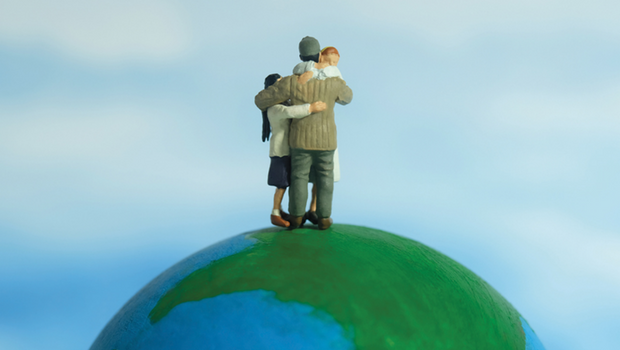Staying Serene in Turbulent Times: How to Turn Anxiety into Positive Action
In this day and age, we have good reason to toss and turn in our beds at night. As our nation faces climate catastrophes, acrid politics, stubborn inflation, unpredictable virus variants and hot-button issues like abortion and guns, there’s good reason our collective anxiety levels are at a high pitch. A recent Yale survey found that 70 percent of Americans report being anxious or depressed about global warming, and a Penn State survey this year found that 84 percent of us say we are “extremely worried” or “very worried” about where the country is headed. Researchers are coining new terms: “polycrisis”, for complex, cascading crises in interacting systems, and “pre-traumatic stress disorder”, when fear of an outcome makes it as good as real to our psyches.
“It’s easy for people to feel overwhelmed now, feeling there are breakdowns and threats on many fronts. People can wonder ‘Where do I even start?’ and feel powerless and hopeless and numb,” says psychiatrist Janet Lewis, M.D., a founder of the nationwide Climate Psychiatry Alliance and a University of Rochester clinical assistant professor of psychiatry. “We are part of a complex system that is moving into new ways of functioning, but there’s no way of predicting ahead of time exactly what all the features of the new ways of operating will be. That makes it impossible for us to wrap our minds around everything that is happening.”
Still, she adds, “We are also by definition part of the system, and therefore have a responsibility to do what we can. We can’t sit on the sidelines and merely hope that things transform in good directions. The situation being so serious also means that what we do now is really important.”
To move from anxiety into effective action, mental health experts advise several strategies: taking a wider perspective, building resilience through self-care and taking individual steps to make a collective difference. As the Dalai Lama encourages, “If you think you are too small to make a difference, try sleeping with a mosquito!”
Taking a Wider Perspective
News reports almost always sound dire—just like the amygdala of our brains, journalists often see their function as focusing on threats to alert us to dangers. “Still, if you take the long view of history, we are much better off than we were 200 years ago or 1,000 years ago, but it took many years to make those changes,” counsels Robert L. Leahy, Ph.D., director of the American Institute for Cognitive Therapy and author of the bestselling The Worry Cure and the upcoming If Only.
“We never know if something is hopeless until we have all the data, and we seldom have all the data,” he says. “And when it comes to political emotions, many of the predictions that are made by the ‘talking heads’ in media never come true.”
Leahy counsels patience: “Social change does not come about by one person doing something. That usually comes about by a long process of millions of people changing their attitudes and changing their behavior. Small efforts can be made on a daily basis that move this slow process forward. We need to take a longer view, rather than expect immediate change.”
In this ongoing process, anxiety has its rightful place. “Anxiety makes us look around, figure out solutions and act. This can absolutely be turned into something positive,” says neuropsychologist Barbara Easterlin, of Jackson, Wyoming, an expert on eco-anxiety who is on the steering committee of the Climate Psychology Alliance of North America. “Doing just one thing to help the planet consistently helps defeat anxiety.”
Taking action moves us into our power—as 15-year-old Greta Thunberg demonstrated by holding a sign outside the Swedish parliament. Personal actions matter because numbers add up. Only 25 percent of individuals in a social group need to make a shift before significant social change follows, conclude researchers at the University of Pennsylvania School of Engineering and Applied Science that analyzed a decade of societal changes in voting, health, technology and finance. Once a group reaches that tipping point, it can trigger a change in the rest of society, says study author Damon Centola, Ph.D., author of Change: How to Make Big Things Happen.
Building Resilience with Self-Care
Fears about the shape of the planet and nation are often piled on top of our everyday living anxieties about family and finances, which can induce emotional overload. “We all have a ‘zone of resilience’ or ‘window of tolerance’, outside of which we become more reactive, less able to function effectively. But it is not fixed. We can learn tools to expand it and cultivate the capacity to be with more,” says Easterlin.
Therapy can be a part of that process by challenging us to examine “the mental narratives that can exacerbate distress,” says Leslie Davenport, a climate psychology consultant and author of Emotional Resiliency in the Era of Climate Change. It’s important to find a therapist, she says, that “validates that your feelings are a normal response to an existential crisis.” She has helped develop new programs at the American Psychology Association and the California Institute of Integral Studies to train therapists in treating eco-anxiety. For low-cost online support, the Good Grief Network offers a 10-step, 10-week program to help process personal anxiety and grief about climate change. People are also sitting down to share their distress at climate cafes, small local gatherings springing up across the country and globe, including some online.
Getting enough sleep, eating healthy and exercising are also key self-care strategies. When anxiety strikes, psychologists advise shifting attention from the head to the body, using such approaches as mindful breathing, dancing and grounding. Meditation, easily accessed these days through apps like Calm and Headspace, helps us to enter into what religious and spiritual teachings call “the still point within.”




























